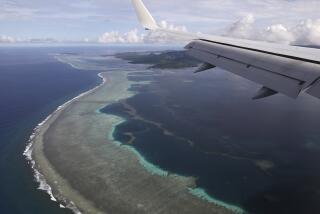Micronesia Wants Piece of Pacific Prosperity : Development: Many islanders feel that the United States hasn’t done enough to help. Some think that they should turn toward Japan.
- Share via
POHNPEI, Micronesia — The Pacific Century is coming, but many people on the tropical island states of Micronesia are afraid that it may pass them by.
Despite four decades of rule by Washington, Micronesia’s economy lags the increasingly prosperous countries of the Pacific Rim.
Its biggest towns remain dusty backwaters in the blue seas of the Pacific.
The picturesque islands, east of the Philippines and south of Japan, were used to test atomic weapons at the height of the Cold War and are still used for tests of Star Wars antimissile technology.
The U.S. Army plans to incinerate chemical weapons transported thousands of miles by ship from Germany on Johnston Island, West of Hawaii, despite concern by local officials about the risk of contamination.
When the Federated States of Micronesia and the Marshall Islands signed compacts of association with the United States and the Northern Marianas became an American Commonwealth in 1986, their leaders were optimistic that Washington would provide substantial assistance to speed their economic development.
Federation President John Hagelgam said the compact’s promise of rapid economic development has been “slow in coming.”
In Saipan, one of Micronesia’s more prosperous islands, residents complain about shortages of power and water supplies, and about the poor state of roads leading to historic World War II battle sites visited by thousands of Japanese tourists.
In the Marshall Islands capital of Majuro, piles of garbage rot on street corners. Health standards have fallen sharply because of obsolete hospitals, poor equipment and lack of trained medical personnel.
Tosiwo Nokagame, the first president of the federation, said compact funds were supposed to be “seed money to create an economic base” that would allow Micronesia to become economically independent in 15 years.
“The way I see it now, we will not be able to create that economic base within that 15-year period. I feel that we are falling behind,” Nokagame said.
Rep. Stephen Solarz (D-N.Y.), chairman of the House subcommittee on Asian and Pacific affairs, said on a recent trip that Americans must “rediscover the South Pacific. . . and demonstrate our commitment to the region.”
Joe Murphy, a columnist for the Pacific Daily News in Guam, said it may make more sense for Micronesians to turn to the Japanese for help, because they “seem more interested in developing tourism, fishing and even tropical agriculture in the islands.”
Complaints about lack of services in the Northern Marianas, 1,000 miles south of Japan, have been muted somewhat by a boom fueled by Japanese tourism and investment in the garment and construction industries.
More than 300,000 tourists came to Saipan last year, and the number is expected to rise this year, officials said.
And some 25,000 contract workers from the Philippines, South Korea, Thailand, Bangladesh and Pakistan have flocked to the Northern Marianas and the U.S. Territory of Guam, attracted by the prospect of high-paid jobs.
Northern Marianas Lt. Gov. Benjamin Manglona said Saipan’s infrastructure will be improved through major road, power, water and sewage projects to attract investors.
Development has been hampered by lack of interest on the part of U.S. investors.
Hagelgam said no American investors have taken advantage of generous provisions in the compact providing $20 million for joint ventures between Micronesian and U.S. business.
He said Americans have paid scant interest to the fate of the string of islands and coral atolls that they have governed since capturing them from Japanese troops in bloody campaigns during World War II.
“We’ve got a lot of money from the compact, but it’s not being utilized for the right kind of development projects,” said Simiron Sipenuk, head of the Visitors Bureau on the island of Truk, where scores of Japanese navy vessels sunk by U.S. planes during the war lie just beneath the waters of a placid lagoon.
The money should be used to develop the infrastructure necessary for the tourism, agriculture and fishery industries, which would create an economic base for the islands, said Sipenuk.
Nokagame is concerned that the lack of economic progress may prompt Micronesians to seek even closer ties with Washington when the compacts lapse early in the next century rather than work for the independence of the Pacific’s island states.
Many leaders reject the idea of severing ties with the United States despite frustration at the way Micronesian interests have been treated by Washington.
“We believe independence is not necessary. We can work out our differences with Uncle Sam,” Manglona said.
More to Read
Sign up for Essential California
The most important California stories and recommendations in your inbox every morning.
You may occasionally receive promotional content from the Los Angeles Times.












